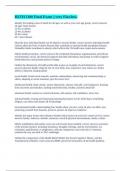HLTH 1100 Final Exam || very Flawless.
Identify the leading cause of death for all ages, as well as your own age group. correct answers
all ages: heart disease
15-24: accidents
25-44: accidents
45-64: cancer
65+: heart disease
Describe how individual health can be linked to societal health. correct answers individual health
choices affect the lives of others because they contribute to national health and global diseases.
Unhealthy habits contribute to obesity which affects the US health care system and economy.
Define health promotion. correct answers the combined educational, organizational, procedural,
environmental, social, and financial supports that help individuals and groups to reduce negative
health behaviors and promote positive change
Outline the dimensions of health and be able to give an example of each dimension. correct
answers physical health: shape & size of your body, how responsive your senses are, body's
ability to function, healing ability
social health: broad social network, maintain relationships, interacting and communicating w/
others, adapting to social situations, give & receive love
intellectual health: think clearly, reason objectively, analyze critically, use brainpower, learning
from successes and mistakes, making sound decisions, healthy curiosity about life
emotional health: express or control emotions, self-esteem, self-confidence, trust, love
spiritual health: creating and expressing meaning & purpose in life, believing in something,
religion, care about and respect all living things
environmental health: understanding how health where you live, work, & play can affect you,
protecting yourself from hazards, preserve, protect, & improve conditions
Identify the major factors that influence health (which factors do you have control over?). correct
answers family, behavior, attitude, resources, social & physical environments, media, culture
Define mindfulness and outline ways one can become more mindful. correct answers awareness
of the present moment, including sensations, thoughts, feelings, and the environment, w/o
evaluation, qualification, or judgement; cultivate compassion, start each day w/ intention,
examine the way you deal w/ life's challenges
Outline the components of the Health Belief Model, the Social Cognitive Theory, and the
Transtheoretical Model. correct answers HBM: perceived seriousness of the health problem,
,perceived susceptibility to the health problem, perceived benefits, perceived barriers, cues to
action
SCT: the social environment in which we live, our thoughts or cognition, and our behaviors
TM: 1- precontemplation
2-contemplation
3- preparation
4- action
5- maintenance
6-termination
Describe how an individual can find valid and reliable health information on the internet. correct
answers look for websites sponsored by an official gov't agency, a university or college, or a
hospital; search for professionally peer-reviewed journals, consult the CDC, visit the WHO,
gather information from two or more reliable sources
Describe the components of a S.M.A.R.T goal/objective. correct answers S- specific
M- measurable
A- action oriented
R- realistic
T- Time oriented
Explain how others can be instrumental in the behavior change process. correct answers others
can help you stay accountable and check in w/ you on your goals
Identify the elements that psychologically healthy people display. correct answers they feel good
about themselves, they feel comfortable w/ other people, respect other people, have compassion
for others, they are "self-compassionate", they control tension and anxiety, they meet the
demands of life, they curb hate and guilt, they maintain a positive outlook, they value diversity,
they appreciate and respect the world around them
Differentiate between mental, emotional, social, and spiritual health. correct answers mental:
values, attitudes, beliefs
emotional: emotional reactions to life
social: ability to use social supports, ability to adapt to various situations, ability to interact w/
other people
spiritual: having a sense of meaning and purpose in life, feeling connected w/ other people and
w/ nature
Outline Maslow's Hierarchy of Needs and describe why each level is important. correct answers
from bottom to top-
, survival needs: food, water, sleep, exercise, sexual expression
security needs: shelter, safety, protection
social needs: belonging, affection, acceptance
esteem needs: self-respect, respect for others, accomplishment
self-actualization: creativity, spirituality, fulfillment of potential
Define and differentiate between self-esteem and self-efficacy. correct answers self-esteem: one's
realistic sense of self-respect or self-worth
self-efficacy: one's belief about whether he or she can successfully engage in and execute a
specific behavior
Differentiate between mood disorders and anxiety disorders. correct answers mood disorders:
involving persistent emotional states, such as sadness, despair, hopelessness, or euphoria, some
examples are major depression, persistent depressive disorder, bipolar disorder, & seasonal
affective disorder
anxiety disorders: persistent feelings of threat & worry, some examples are generalized anxiety
disorder, panic disorders, & phobic disorders
Describe risk factors, warning signs, and preventative actions for suicide. correct answers risk
factors: family history, previous suicide attempts, excessive drug and alcohol use, prolonged
depression, financial difficulties, serious illness in self or loved one, lose of a loved one
warning signs: recent loss & inability to let go of grief, history of depression, change in
personality, behavior, sexual interest, appearance, or sleeping & eating habits, a direct or indirect
statement about committing suicide, final preparations, preoccupation with themes of death
preventative actions: monitor warning signs, take threats seriously, let the person know how
much you care, ask directly, take action, help the person think about alternatives to suicide, tell
their loved ones or a counselor
Differentiate between the various mental health professionals. correct answers psychiatrist: MD,
4 years of mental health training, can prescribe medications and may have admitting privileges at
a local hospital
psychologist: doctoral degree in counseling or clinical psychology (PhD) + several years of
supervised practice to earn license; cognitive-behavioral therapy and specialties including family
or sexual counseling





